ITECH5404 - BPM & Change: Ballarat Dentistry Case Study
VerifiedAdded on 2023/06/11
|18
|2576
|109
Case Study
AI Summary
This case study delves into the business processes of Ballarat Dentistry, focusing on comprehensive examinations and treatment procedures. It employs business process management (BPM) principles to analyze existing workflows, using tools like process categorization models, capability maturity models, and case function matrices. The report includes detailed process models for both comprehensive exams and treatment processes, followed by 7PGM discussions and cycle-time analyses. The study proposes redesigned processes to enhance efficiency and effectiveness, incorporating a BPMS architecture for improved management and automation. The conclusion emphasizes the importance of business process management in modern organizations and the need for tools to manage growing business process model accumulations. Desklib provides similar solved assignments and past papers for students.
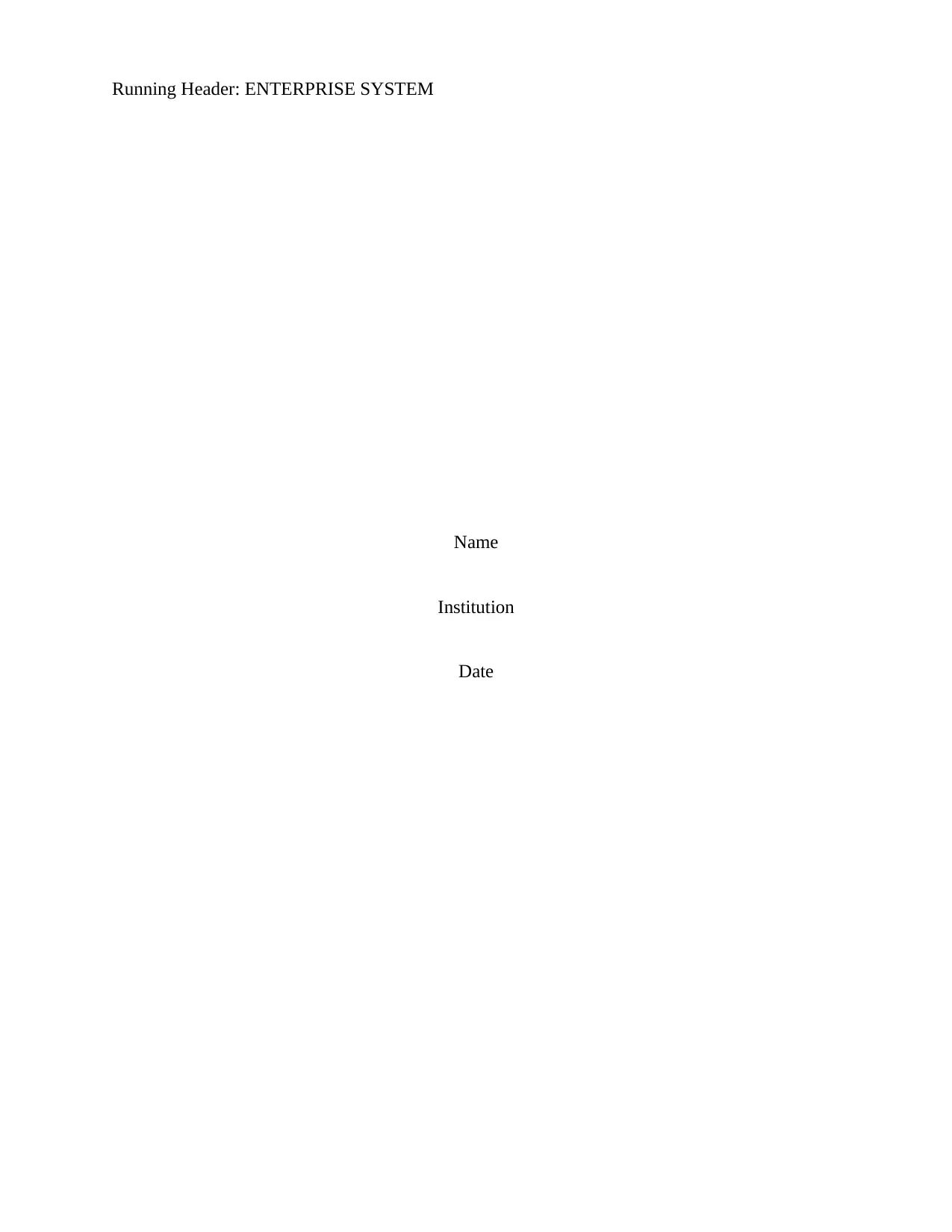
Running Header: ENTERPRISE SYSTEM
Name
Institution
Date
Name
Institution
Date
Paraphrase This Document
Need a fresh take? Get an instant paraphrase of this document with our AI Paraphraser
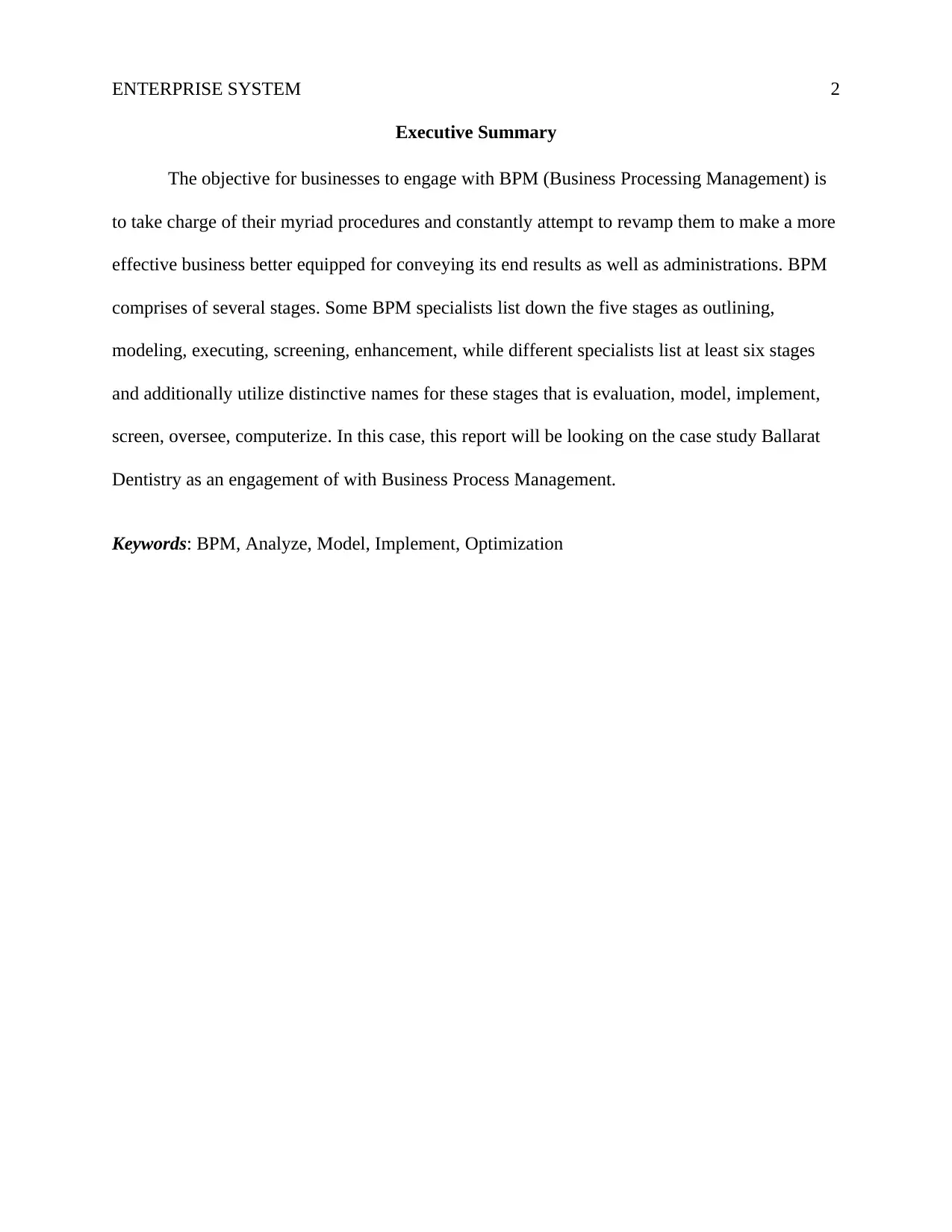
ENTERPRISE SYSTEM 2
Executive Summary
The objective for businesses to engage with BPM (Business Processing Management) is
to take charge of their myriad procedures and constantly attempt to revamp them to make a more
effective business better equipped for conveying its end results as well as administrations. BPM
comprises of several stages. Some BPM specialists list down the five stages as outlining,
modeling, executing, screening, enhancement, while different specialists list at least six stages
and additionally utilize distinctive names for these stages that is evaluation, model, implement,
screen, oversee, computerize. In this case, this report will be looking on the case study Ballarat
Dentistry as an engagement of with Business Process Management.
Keywords: BPM, Analyze, Model, Implement, Optimization
Executive Summary
The objective for businesses to engage with BPM (Business Processing Management) is
to take charge of their myriad procedures and constantly attempt to revamp them to make a more
effective business better equipped for conveying its end results as well as administrations. BPM
comprises of several stages. Some BPM specialists list down the five stages as outlining,
modeling, executing, screening, enhancement, while different specialists list at least six stages
and additionally utilize distinctive names for these stages that is evaluation, model, implement,
screen, oversee, computerize. In this case, this report will be looking on the case study Ballarat
Dentistry as an engagement of with Business Process Management.
Keywords: BPM, Analyze, Model, Implement, Optimization
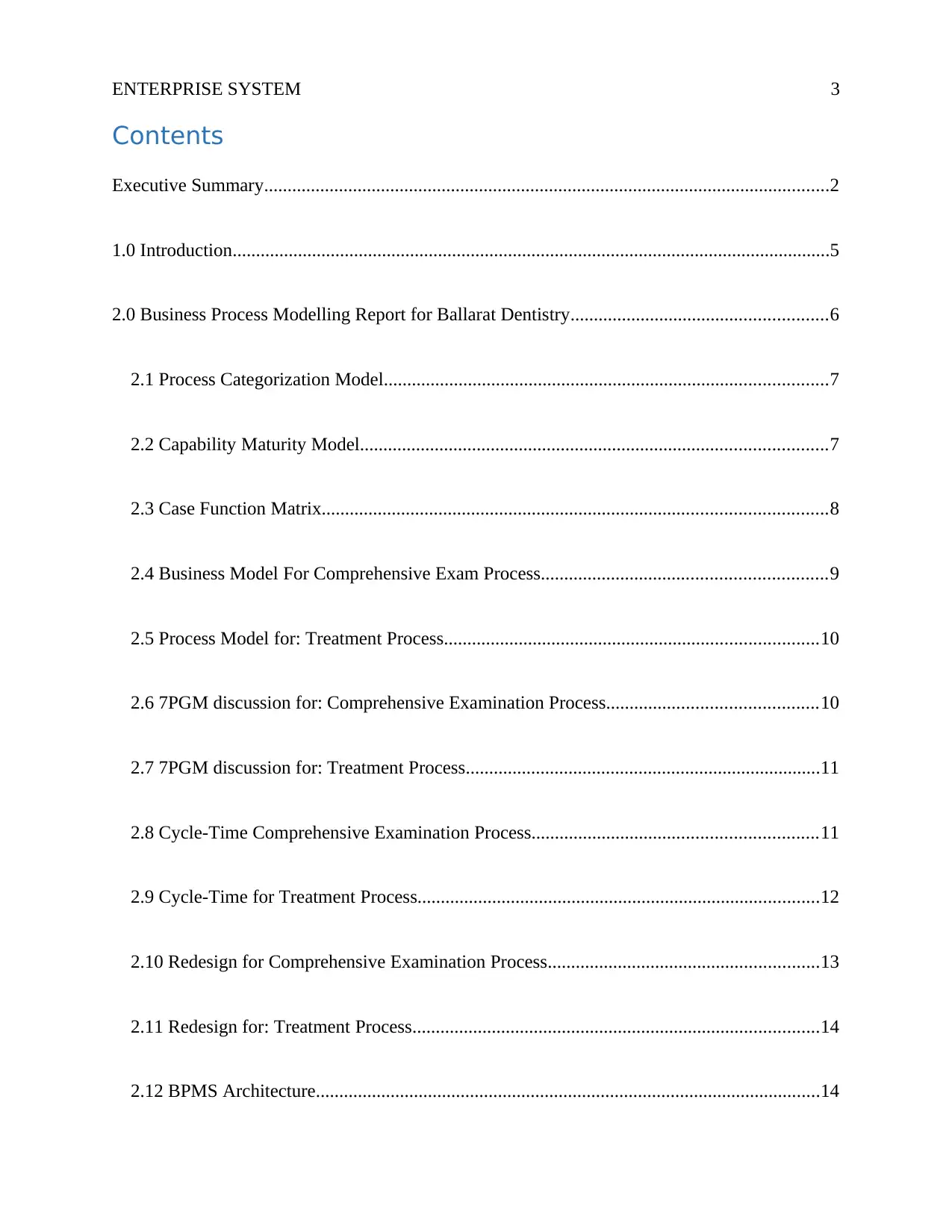
ENTERPRISE SYSTEM 3
Contents
Executive Summary.........................................................................................................................2
1.0 Introduction................................................................................................................................5
2.0 Business Process Modelling Report for Ballarat Dentistry.......................................................6
2.1 Process Categorization Model...............................................................................................7
2.2 Capability Maturity Model....................................................................................................7
2.3 Case Function Matrix............................................................................................................8
2.4 Business Model For Comprehensive Exam Process.............................................................9
2.5 Process Model for: Treatment Process................................................................................10
2.6 7PGM discussion for: Comprehensive Examination Process.............................................10
2.7 7PGM discussion for: Treatment Process............................................................................11
2.8 Cycle-Time Comprehensive Examination Process.............................................................11
2.9 Cycle-Time for Treatment Process......................................................................................12
2.10 Redesign for Comprehensive Examination Process..........................................................13
2.11 Redesign for: Treatment Process.......................................................................................14
2.12 BPMS Architecture............................................................................................................14
Contents
Executive Summary.........................................................................................................................2
1.0 Introduction................................................................................................................................5
2.0 Business Process Modelling Report for Ballarat Dentistry.......................................................6
2.1 Process Categorization Model...............................................................................................7
2.2 Capability Maturity Model....................................................................................................7
2.3 Case Function Matrix............................................................................................................8
2.4 Business Model For Comprehensive Exam Process.............................................................9
2.5 Process Model for: Treatment Process................................................................................10
2.6 7PGM discussion for: Comprehensive Examination Process.............................................10
2.7 7PGM discussion for: Treatment Process............................................................................11
2.8 Cycle-Time Comprehensive Examination Process.............................................................11
2.9 Cycle-Time for Treatment Process......................................................................................12
2.10 Redesign for Comprehensive Examination Process..........................................................13
2.11 Redesign for: Treatment Process.......................................................................................14
2.12 BPMS Architecture............................................................................................................14
⊘ This is a preview!⊘
Do you want full access?
Subscribe today to unlock all pages.

Trusted by 1+ million students worldwide

ENTERPRISE SYSTEM 4
3.0 Conclusion...............................................................................................................................15
4.0 References................................................................................................................................16
3.0 Conclusion...............................................................................................................................15
4.0 References................................................................................................................................16
Paraphrase This Document
Need a fresh take? Get an instant paraphrase of this document with our AI Paraphraser
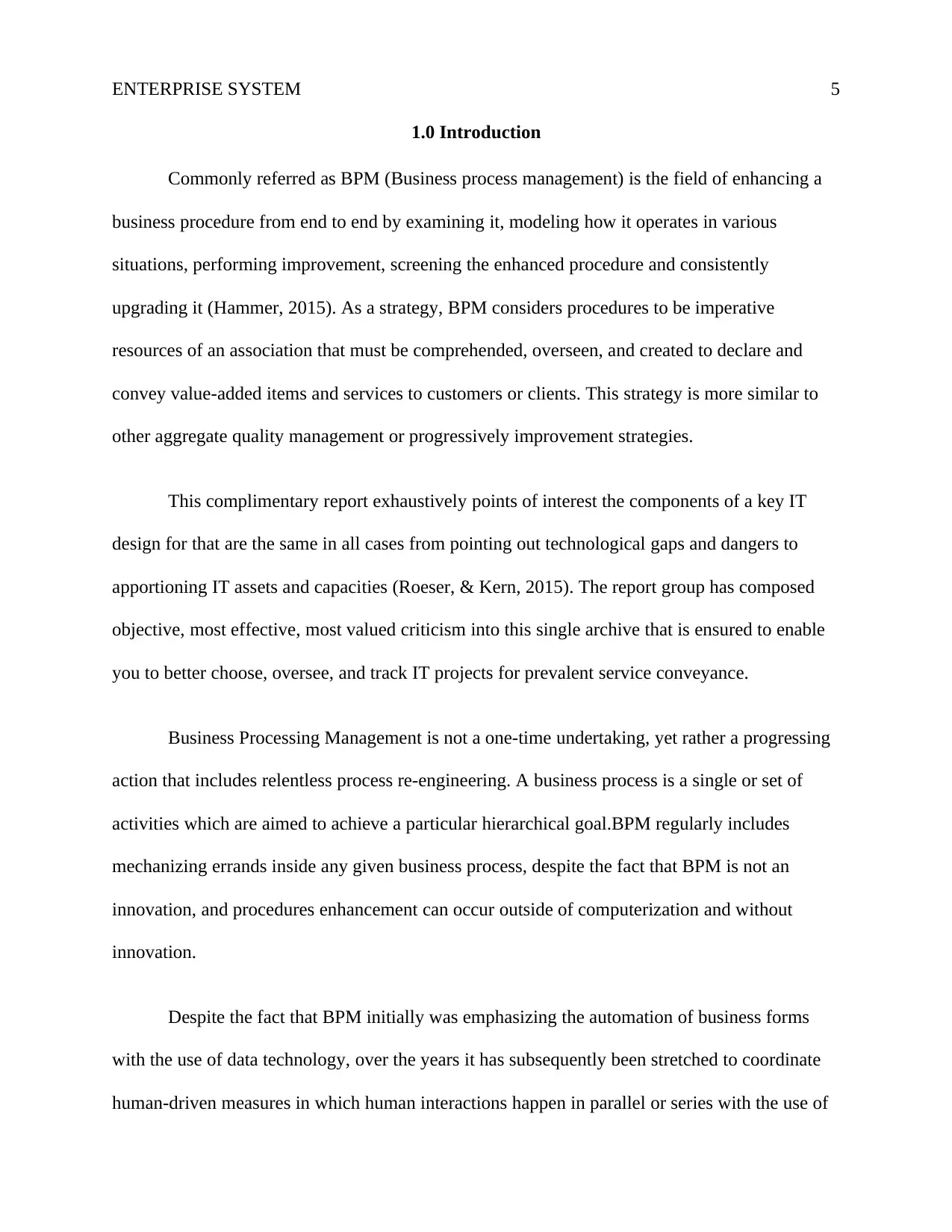
ENTERPRISE SYSTEM 5
1.0 Introduction
Commonly referred as BPM (Business process management) is the field of enhancing a
business procedure from end to end by examining it, modeling how it operates in various
situations, performing improvement, screening the enhanced procedure and consistently
upgrading it (Hammer, 2015). As a strategy, BPM considers procedures to be imperative
resources of an association that must be comprehended, overseen, and created to declare and
convey value-added items and services to customers or clients. This strategy is more similar to
other aggregate quality management or progressively improvement strategies.
This complimentary report exhaustively points of interest the components of a key IT
design for that are the same in all cases from pointing out technological gaps and dangers to
apportioning IT assets and capacities (Roeser, & Kern, 2015). The report group has composed
objective, most effective, most valued criticism into this single archive that is ensured to enable
you to better choose, oversee, and track IT projects for prevalent service conveyance.
Business Processing Management is not a one-time undertaking, yet rather a progressing
action that includes relentless process re-engineering. A business process is a single or set of
activities which are aimed to achieve a particular hierarchical goal.BPM regularly includes
mechanizing errands inside any given business process, despite the fact that BPM is not an
innovation, and procedures enhancement can occur outside of computerization and without
innovation.
Despite the fact that BPM initially was emphasizing the automation of business forms
with the use of data technology, over the years it has subsequently been stretched to coordinate
human-driven measures in which human interactions happen in parallel or series with the use of
1.0 Introduction
Commonly referred as BPM (Business process management) is the field of enhancing a
business procedure from end to end by examining it, modeling how it operates in various
situations, performing improvement, screening the enhanced procedure and consistently
upgrading it (Hammer, 2015). As a strategy, BPM considers procedures to be imperative
resources of an association that must be comprehended, overseen, and created to declare and
convey value-added items and services to customers or clients. This strategy is more similar to
other aggregate quality management or progressively improvement strategies.
This complimentary report exhaustively points of interest the components of a key IT
design for that are the same in all cases from pointing out technological gaps and dangers to
apportioning IT assets and capacities (Roeser, & Kern, 2015). The report group has composed
objective, most effective, most valued criticism into this single archive that is ensured to enable
you to better choose, oversee, and track IT projects for prevalent service conveyance.
Business Processing Management is not a one-time undertaking, yet rather a progressing
action that includes relentless process re-engineering. A business process is a single or set of
activities which are aimed to achieve a particular hierarchical goal.BPM regularly includes
mechanizing errands inside any given business process, despite the fact that BPM is not an
innovation, and procedures enhancement can occur outside of computerization and without
innovation.
Despite the fact that BPM initially was emphasizing the automation of business forms
with the use of data technology, over the years it has subsequently been stretched to coordinate
human-driven measures in which human interactions happen in parallel or series with the use of
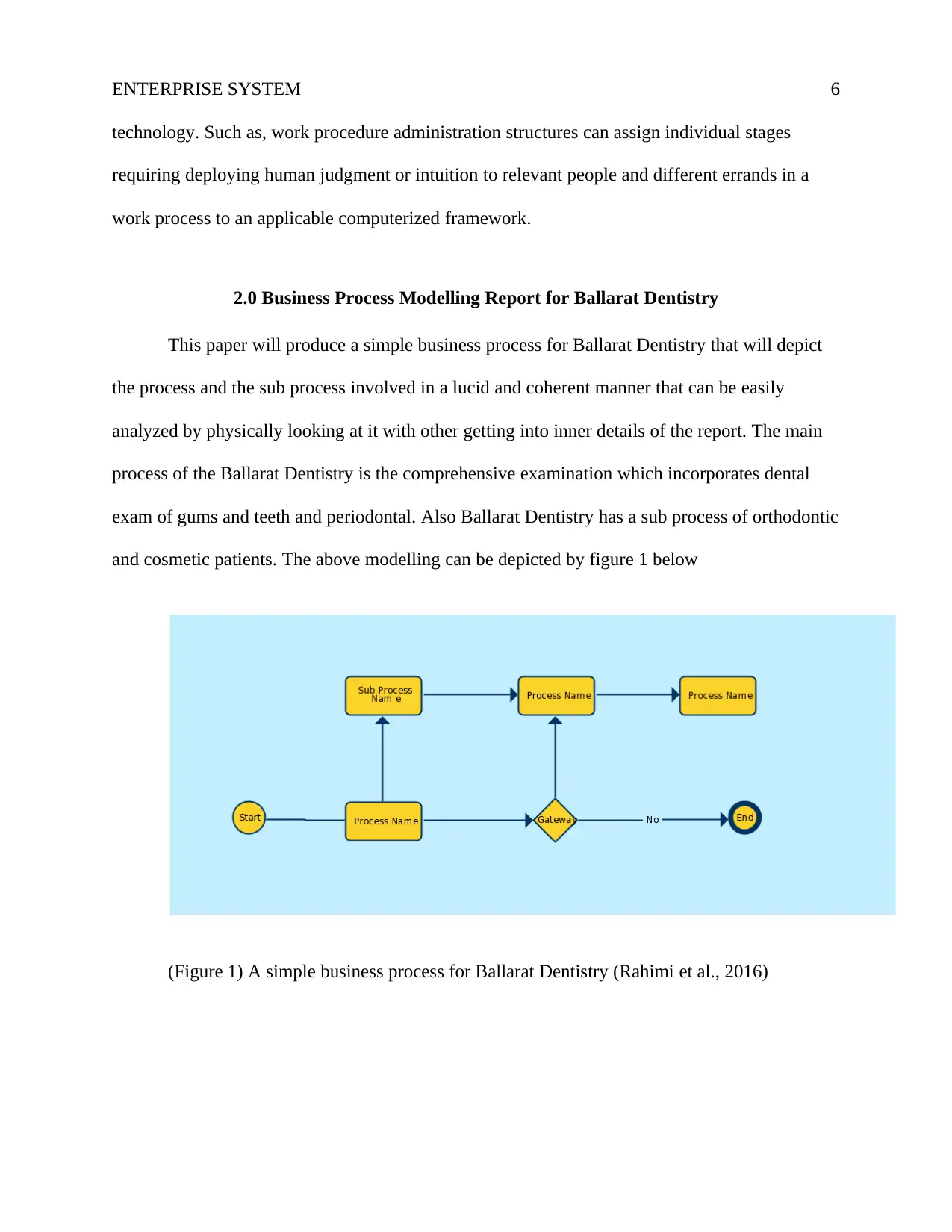
ENTERPRISE SYSTEM 6
technology. Such as, work procedure administration structures can assign individual stages
requiring deploying human judgment or intuition to relevant people and different errands in a
work process to an applicable computerized framework.
2.0 Business Process Modelling Report for Ballarat Dentistry
This paper will produce a simple business process for Ballarat Dentistry that will depict
the process and the sub process involved in a lucid and coherent manner that can be easily
analyzed by physically looking at it with other getting into inner details of the report. The main
process of the Ballarat Dentistry is the comprehensive examination which incorporates dental
exam of gums and teeth and periodontal. Also Ballarat Dentistry has a sub process of orthodontic
and cosmetic patients. The above modelling can be depicted by figure 1 below
(Figure 1) A simple business process for Ballarat Dentistry (Rahimi et al., 2016)
technology. Such as, work procedure administration structures can assign individual stages
requiring deploying human judgment or intuition to relevant people and different errands in a
work process to an applicable computerized framework.
2.0 Business Process Modelling Report for Ballarat Dentistry
This paper will produce a simple business process for Ballarat Dentistry that will depict
the process and the sub process involved in a lucid and coherent manner that can be easily
analyzed by physically looking at it with other getting into inner details of the report. The main
process of the Ballarat Dentistry is the comprehensive examination which incorporates dental
exam of gums and teeth and periodontal. Also Ballarat Dentistry has a sub process of orthodontic
and cosmetic patients. The above modelling can be depicted by figure 1 below
(Figure 1) A simple business process for Ballarat Dentistry (Rahimi et al., 2016)
⊘ This is a preview!⊘
Do you want full access?
Subscribe today to unlock all pages.

Trusted by 1+ million students worldwide
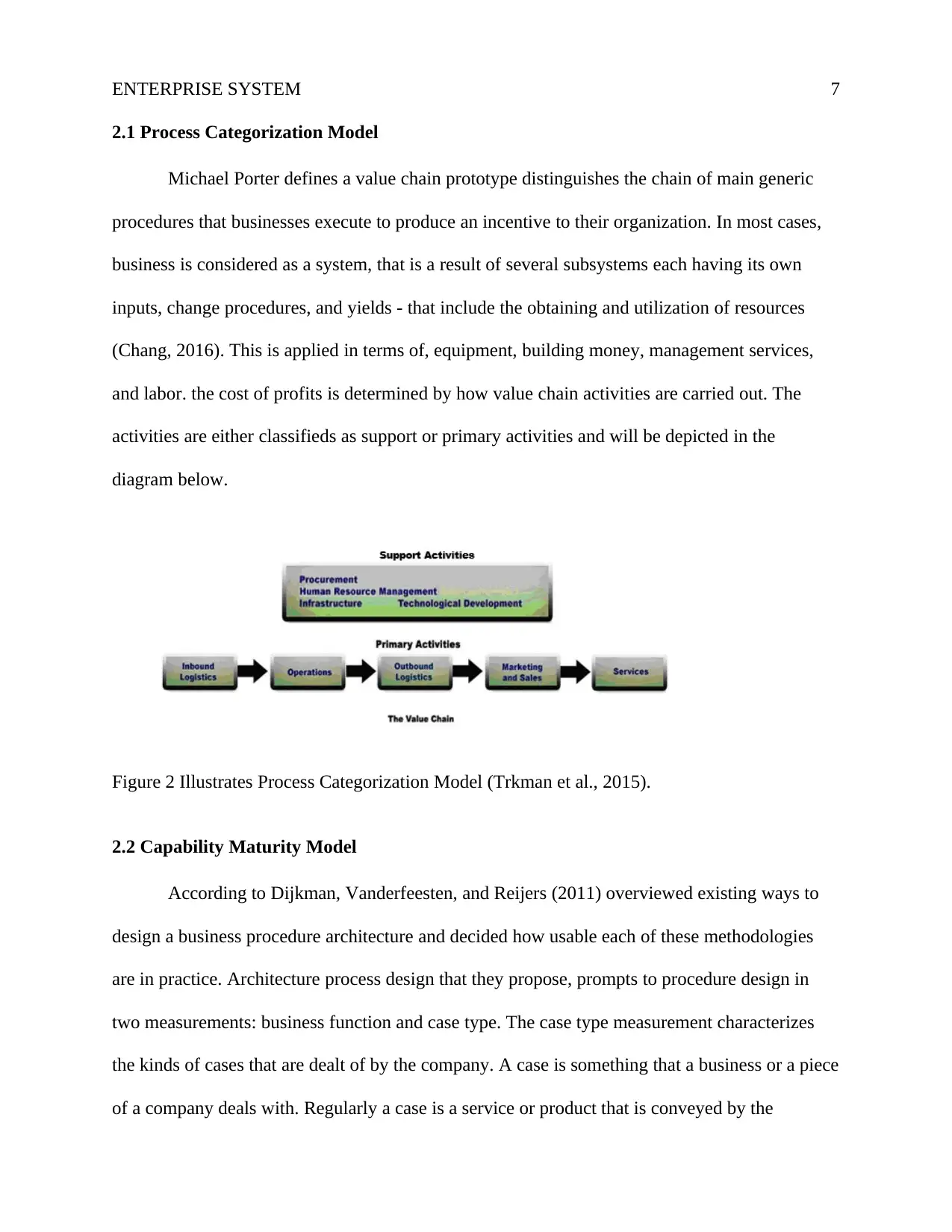
ENTERPRISE SYSTEM 7
2.1 Process Categorization Model
Michael Porter defines a value chain prototype distinguishes the chain of main generic
procedures that businesses execute to produce an incentive to their organization. In most cases,
business is considered as a system, that is a result of several subsystems each having its own
inputs, change procedures, and yields - that include the obtaining and utilization of resources
(Chang, 2016). This is applied in terms of, equipment, building money, management services,
and labor. the cost of profits is determined by how value chain activities are carried out. The
activities are either classifieds as support or primary activities and will be depicted in the
diagram below.
Figure 2 Illustrates Process Categorization Model (Trkman et al., 2015).
2.2 Capability Maturity Model
According to Dijkman, Vanderfeesten, and Reijers (2011) overviewed existing ways to
design a business procedure architecture and decided how usable each of these methodologies
are in practice. Architecture process design that they propose, prompts to procedure design in
two measurements: business function and case type. The case type measurement characterizes
the kinds of cases that are dealt of by the company. A case is something that a business or a piece
of a company deals with. Regularly a case is a service or product that is conveyed by the
2.1 Process Categorization Model
Michael Porter defines a value chain prototype distinguishes the chain of main generic
procedures that businesses execute to produce an incentive to their organization. In most cases,
business is considered as a system, that is a result of several subsystems each having its own
inputs, change procedures, and yields - that include the obtaining and utilization of resources
(Chang, 2016). This is applied in terms of, equipment, building money, management services,
and labor. the cost of profits is determined by how value chain activities are carried out. The
activities are either classifieds as support or primary activities and will be depicted in the
diagram below.
Figure 2 Illustrates Process Categorization Model (Trkman et al., 2015).
2.2 Capability Maturity Model
According to Dijkman, Vanderfeesten, and Reijers (2011) overviewed existing ways to
design a business procedure architecture and decided how usable each of these methodologies
are in practice. Architecture process design that they propose, prompts to procedure design in
two measurements: business function and case type. The case type measurement characterizes
the kinds of cases that are dealt of by the company. A case is something that a business or a piece
of a company deals with. Regularly a case is a service or product that is conveyed by the
Paraphrase This Document
Need a fresh take? Get an instant paraphrase of this document with our AI Paraphraser
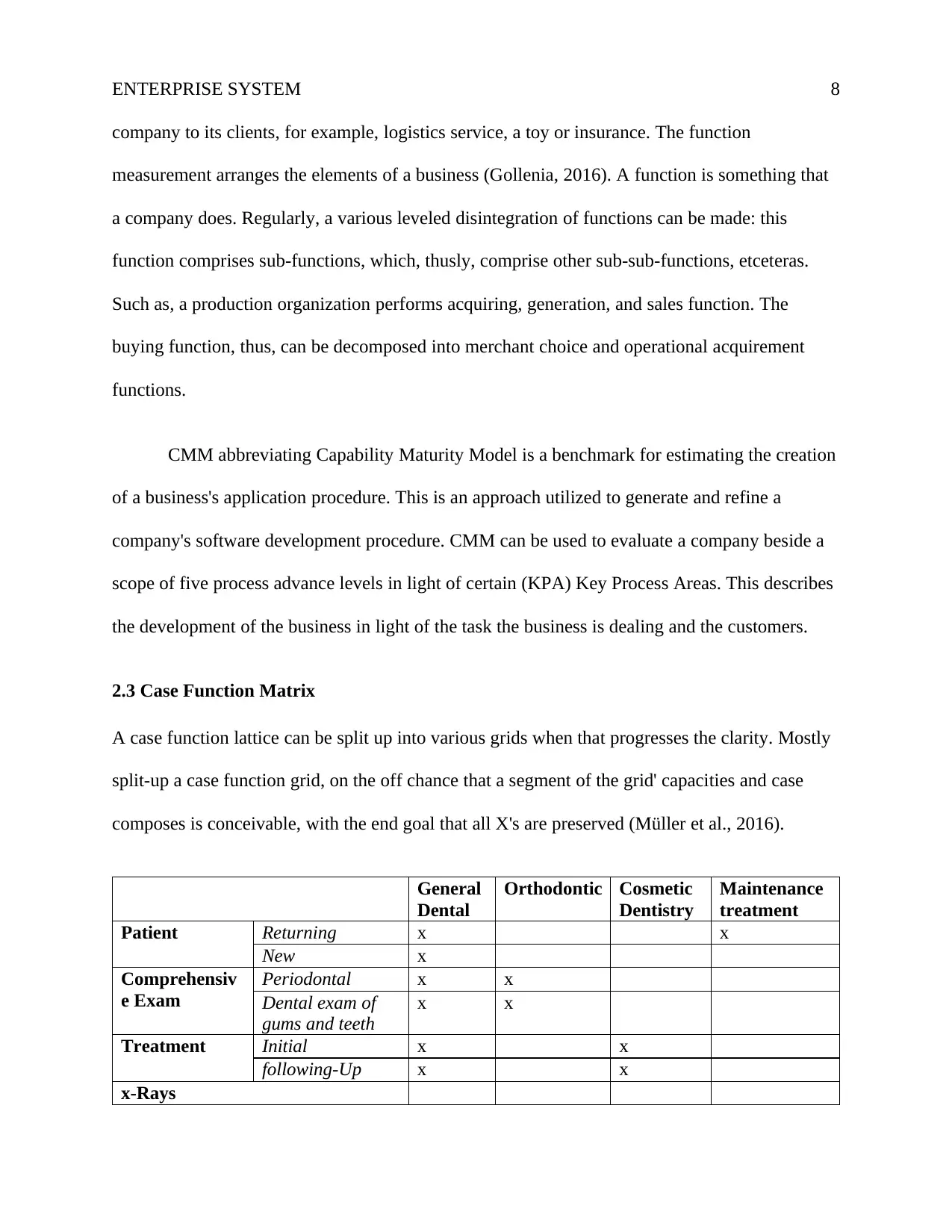
ENTERPRISE SYSTEM 8
company to its clients, for example, logistics service, a toy or insurance. The function
measurement arranges the elements of a business (Gollenia, 2016). A function is something that
a company does. Regularly, a various leveled disintegration of functions can be made: this
function comprises sub-functions, which, thusly, comprise other sub-sub-functions, etceteras.
Such as, a production organization performs acquiring, generation, and sales function. The
buying function, thus, can be decomposed into merchant choice and operational acquirement
functions.
CMM abbreviating Capability Maturity Model is a benchmark for estimating the creation
of a business's application procedure. This is an approach utilized to generate and refine a
company's software development procedure. CMM can be used to evaluate a company beside a
scope of five process advance levels in light of certain (KPA) Key Process Areas. This describes
the development of the business in light of the task the business is dealing and the customers.
2.3 Case Function Matrix
A case function lattice can be split up into various grids when that progresses the clarity. Mostly
split-up a case function grid, on the off chance that a segment of the grid' capacities and case
composes is conceivable, with the end goal that all X's are preserved (Müller et al., 2016).
General
Dental
Orthodontic Cosmetic
Dentistry
Maintenance
treatment
Patient Returning x x
New x
Comprehensiv
e Exam
Periodontal x x
Dental exam of
gums and teeth
x x
Treatment Initial x x
following-Up x x
x-Rays
company to its clients, for example, logistics service, a toy or insurance. The function
measurement arranges the elements of a business (Gollenia, 2016). A function is something that
a company does. Regularly, a various leveled disintegration of functions can be made: this
function comprises sub-functions, which, thusly, comprise other sub-sub-functions, etceteras.
Such as, a production organization performs acquiring, generation, and sales function. The
buying function, thus, can be decomposed into merchant choice and operational acquirement
functions.
CMM abbreviating Capability Maturity Model is a benchmark for estimating the creation
of a business's application procedure. This is an approach utilized to generate and refine a
company's software development procedure. CMM can be used to evaluate a company beside a
scope of five process advance levels in light of certain (KPA) Key Process Areas. This describes
the development of the business in light of the task the business is dealing and the customers.
2.3 Case Function Matrix
A case function lattice can be split up into various grids when that progresses the clarity. Mostly
split-up a case function grid, on the off chance that a segment of the grid' capacities and case
composes is conceivable, with the end goal that all X's are preserved (Müller et al., 2016).
General
Dental
Orthodontic Cosmetic
Dentistry
Maintenance
treatment
Patient Returning x x
New x
Comprehensiv
e Exam
Periodontal x x
Dental exam of
gums and teeth
x x
Treatment Initial x x
following-Up x x
x-Rays
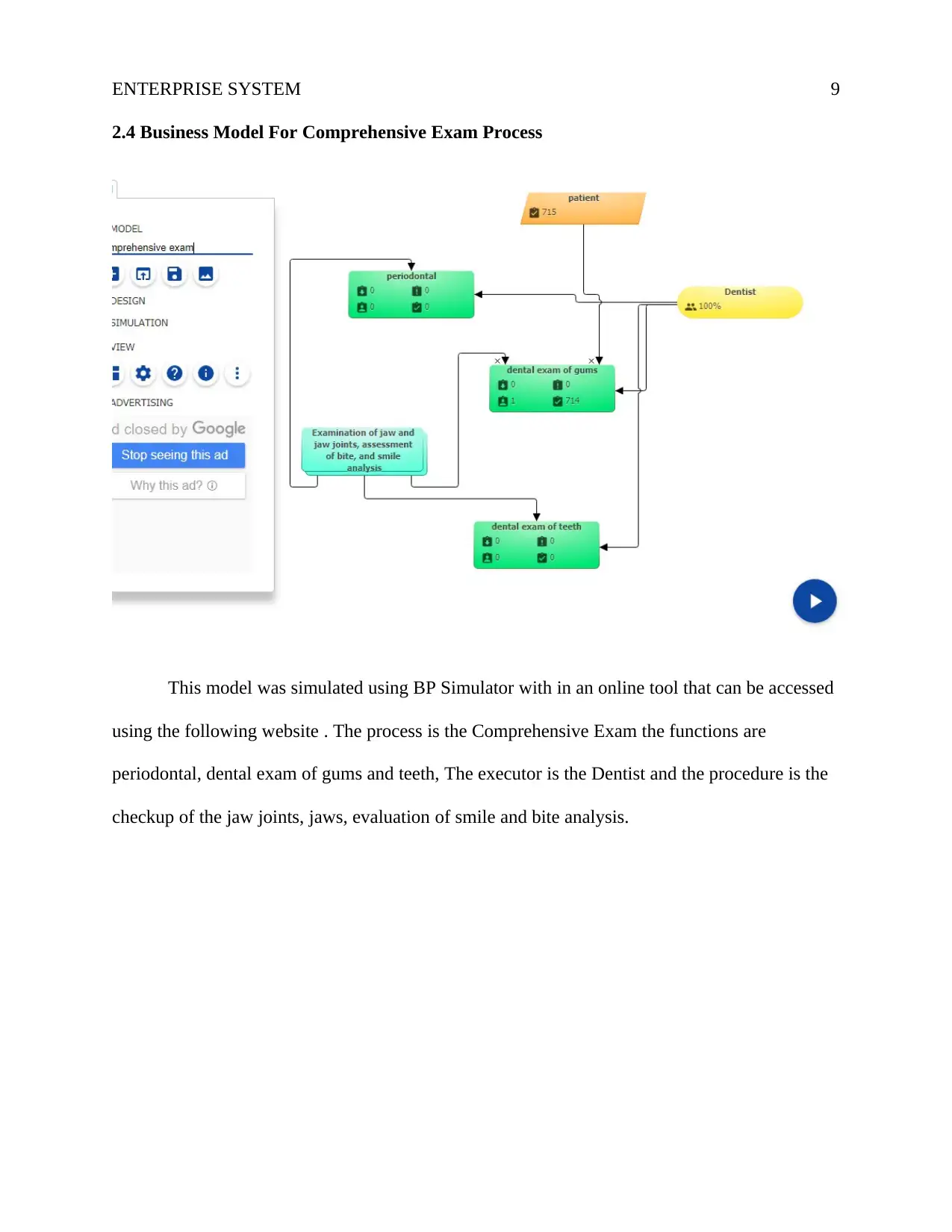
ENTERPRISE SYSTEM 9
2.4 Business Model For Comprehensive Exam Process
This model was simulated using BP Simulator with in an online tool that can be accessed
using the following website . The process is the Comprehensive Exam the functions are
periodontal, dental exam of gums and teeth, The executor is the Dentist and the procedure is the
checkup of the jaw joints, jaws, evaluation of smile and bite analysis.
2.4 Business Model For Comprehensive Exam Process
This model was simulated using BP Simulator with in an online tool that can be accessed
using the following website . The process is the Comprehensive Exam the functions are
periodontal, dental exam of gums and teeth, The executor is the Dentist and the procedure is the
checkup of the jaw joints, jaws, evaluation of smile and bite analysis.
⊘ This is a preview!⊘
Do you want full access?
Subscribe today to unlock all pages.

Trusted by 1+ million students worldwide
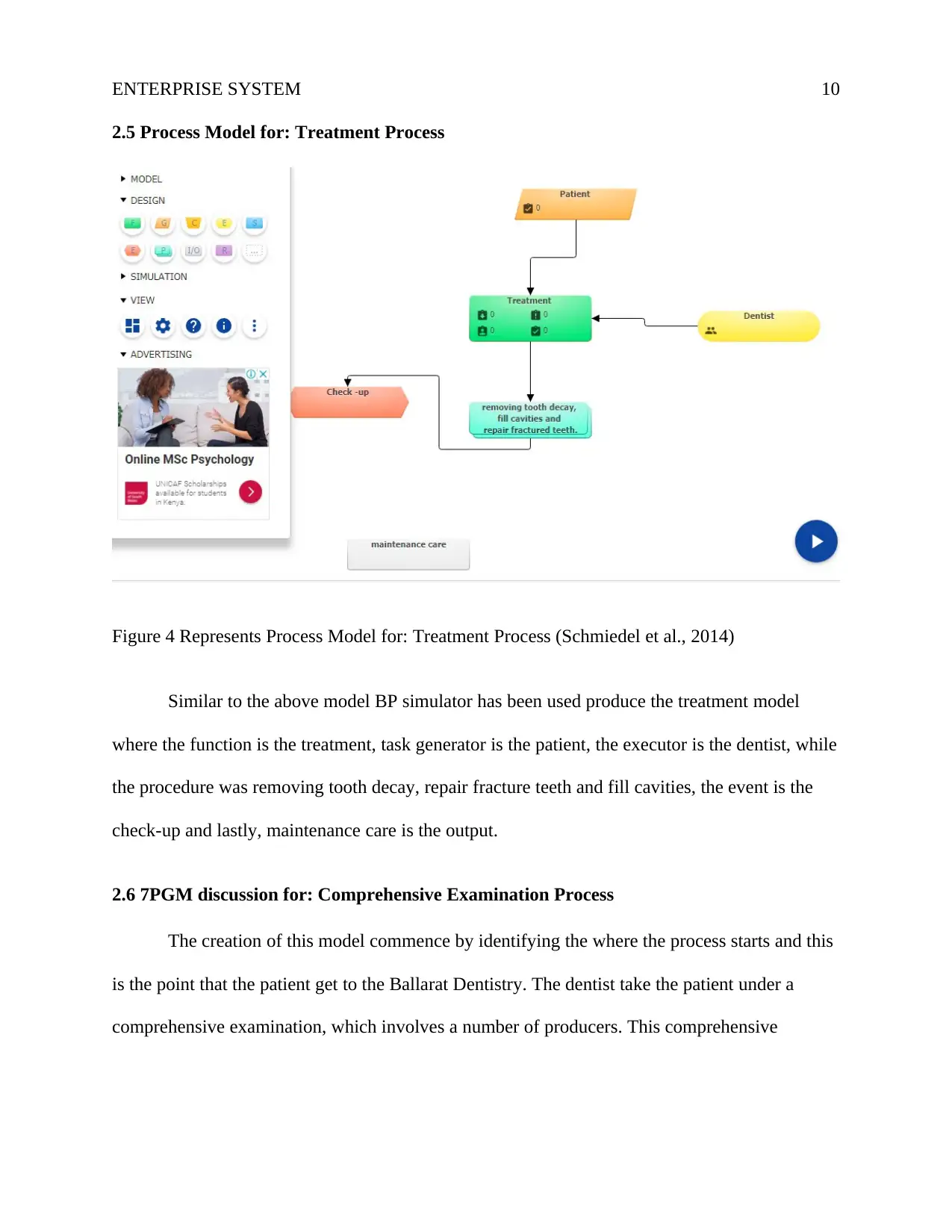
ENTERPRISE SYSTEM 10
2.5 Process Model for: Treatment Process
Figure 4 Represents Process Model for: Treatment Process (Schmiedel et al., 2014)
Similar to the above model BP simulator has been used produce the treatment model
where the function is the treatment, task generator is the patient, the executor is the dentist, while
the procedure was removing tooth decay, repair fracture teeth and fill cavities, the event is the
check-up and lastly, maintenance care is the output.
2.6 7PGM discussion for: Comprehensive Examination Process
The creation of this model commence by identifying the where the process starts and this
is the point that the patient get to the Ballarat Dentistry. The dentist take the patient under a
comprehensive examination, which involves a number of producers. This comprehensive
2.5 Process Model for: Treatment Process
Figure 4 Represents Process Model for: Treatment Process (Schmiedel et al., 2014)
Similar to the above model BP simulator has been used produce the treatment model
where the function is the treatment, task generator is the patient, the executor is the dentist, while
the procedure was removing tooth decay, repair fracture teeth and fill cavities, the event is the
check-up and lastly, maintenance care is the output.
2.6 7PGM discussion for: Comprehensive Examination Process
The creation of this model commence by identifying the where the process starts and this
is the point that the patient get to the Ballarat Dentistry. The dentist take the patient under a
comprehensive examination, which involves a number of producers. This comprehensive
Paraphrase This Document
Need a fresh take? Get an instant paraphrase of this document with our AI Paraphraser
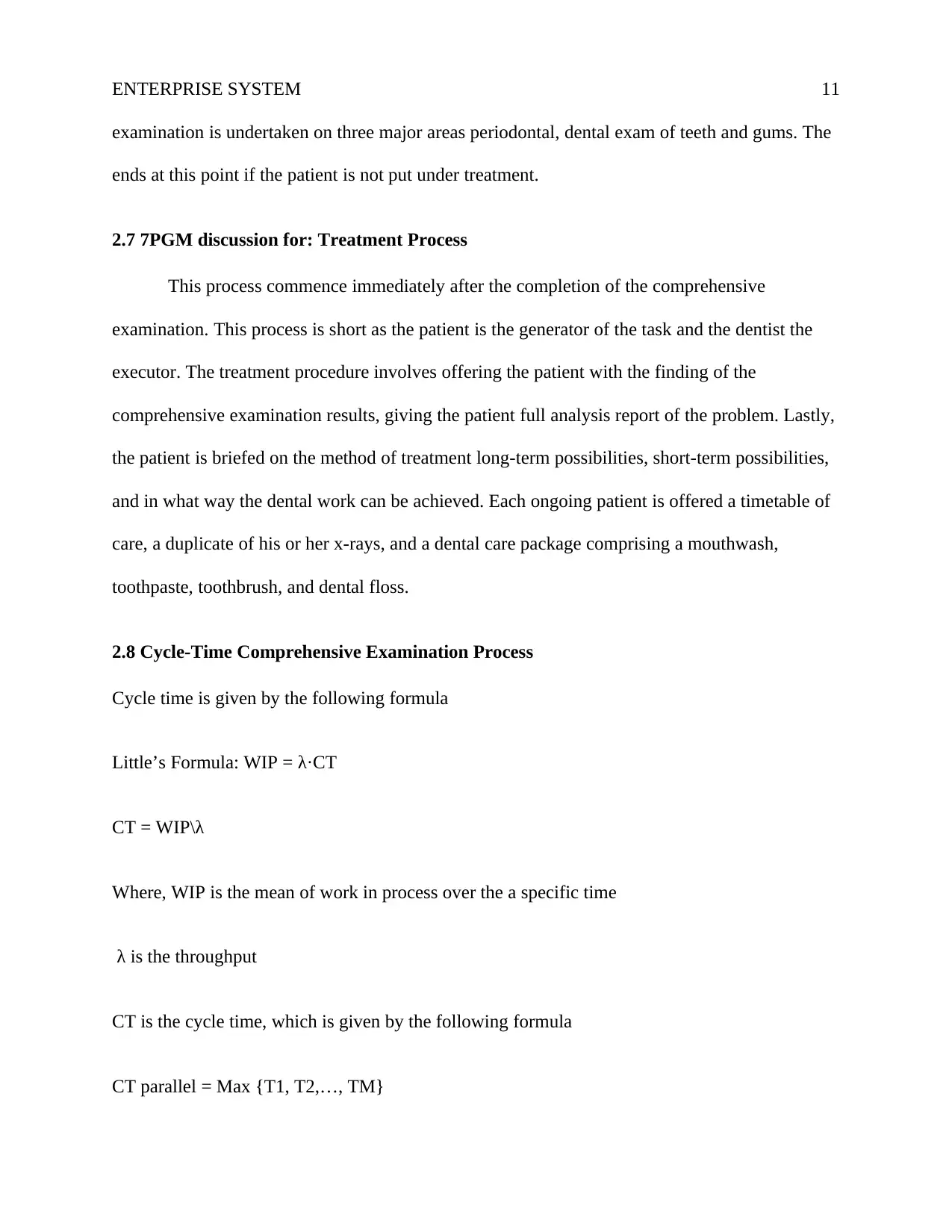
ENTERPRISE SYSTEM 11
examination is undertaken on three major areas periodontal, dental exam of teeth and gums. The
ends at this point if the patient is not put under treatment.
2.7 7PGM discussion for: Treatment Process
This process commence immediately after the completion of the comprehensive
examination. This process is short as the patient is the generator of the task and the dentist the
executor. The treatment procedure involves offering the patient with the finding of the
comprehensive examination results, giving the patient full analysis report of the problem. Lastly,
the patient is briefed on the method of treatment long-term possibilities, short-term possibilities,
and in what way the dental work can be achieved. Each ongoing patient is offered a timetable of
care, a duplicate of his or her x-rays, and a dental care package comprising a mouthwash,
toothpaste, toothbrush, and dental floss.
2.8 Cycle-Time Comprehensive Examination Process
Cycle time is given by the following formula
Little’s Formula: WIP = λ·CT
CT = WIP\λ
Where, WIP is the mean of work in process over the a specific time
λ is the throughput
CT is the cycle time, which is given by the following formula
CT parallel = Max {T1, T2,…, TM}
examination is undertaken on three major areas periodontal, dental exam of teeth and gums. The
ends at this point if the patient is not put under treatment.
2.7 7PGM discussion for: Treatment Process
This process commence immediately after the completion of the comprehensive
examination. This process is short as the patient is the generator of the task and the dentist the
executor. The treatment procedure involves offering the patient with the finding of the
comprehensive examination results, giving the patient full analysis report of the problem. Lastly,
the patient is briefed on the method of treatment long-term possibilities, short-term possibilities,
and in what way the dental work can be achieved. Each ongoing patient is offered a timetable of
care, a duplicate of his or her x-rays, and a dental care package comprising a mouthwash,
toothpaste, toothbrush, and dental floss.
2.8 Cycle-Time Comprehensive Examination Process
Cycle time is given by the following formula
Little’s Formula: WIP = λ·CT
CT = WIP\λ
Where, WIP is the mean of work in process over the a specific time
λ is the throughput
CT is the cycle time, which is given by the following formula
CT parallel = Max {T1, T2,…, TM}
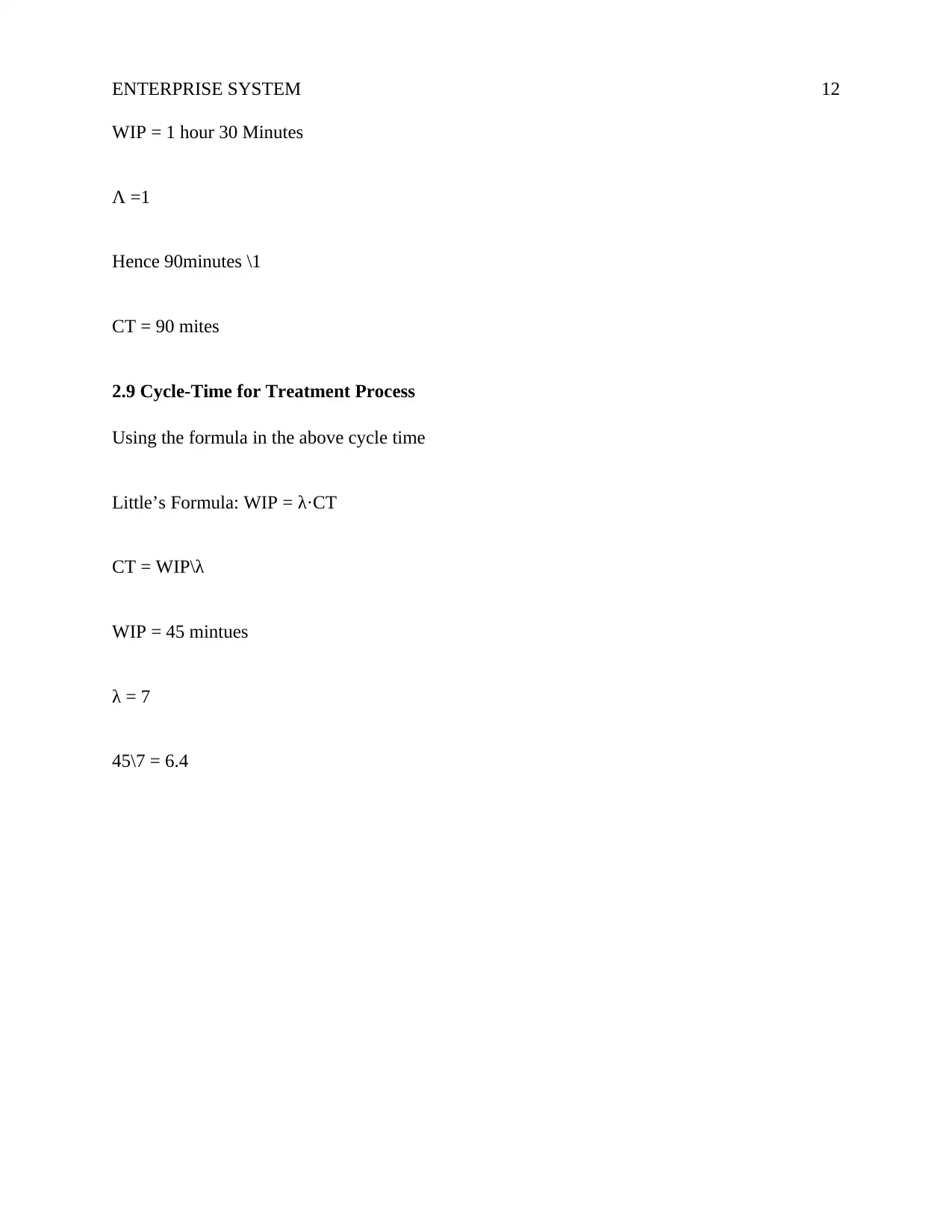
ENTERPRISE SYSTEM 12
WIP = 1 hour 30 Minutes
Λ =1
Hence 90minutes \1
CT = 90 mites
2.9 Cycle-Time for Treatment Process
Using the formula in the above cycle time
Little’s Formula: WIP = λ·CT
CT = WIP\λ
WIP = 45 mintues
λ = 7
45\7 = 6.4
WIP = 1 hour 30 Minutes
Λ =1
Hence 90minutes \1
CT = 90 mites
2.9 Cycle-Time for Treatment Process
Using the formula in the above cycle time
Little’s Formula: WIP = λ·CT
CT = WIP\λ
WIP = 45 mintues
λ = 7
45\7 = 6.4
⊘ This is a preview!⊘
Do you want full access?
Subscribe today to unlock all pages.

Trusted by 1+ million students worldwide
1 out of 18
Related Documents
Your All-in-One AI-Powered Toolkit for Academic Success.
+13062052269
info@desklib.com
Available 24*7 on WhatsApp / Email
![[object Object]](/_next/static/media/star-bottom.7253800d.svg)
Unlock your academic potential
Copyright © 2020–2025 A2Z Services. All Rights Reserved. Developed and managed by ZUCOL.




